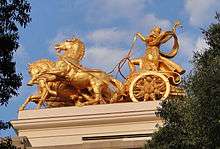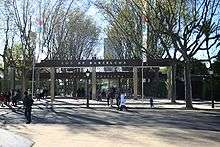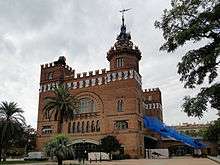Parc de la Ciutadella
| Parc de la Ciutadella | |
|---|---|
|
The park's fountain | |
| Type | Historical garden |
| Location | Barcelona |
| Coordinates | 41°23′17″N 2°11′15″E / 41.38806°N 2.18750°ECoordinates: 41°23′17″N 2°11′15″E / 41.38806°N 2.18750°E |
| Created | 1877 |
| Status | Open all year |
| Website | Parcs i jardins de Barcelona |
The Parc de la Ciutadella (Catalan pronunciation: [ˈparɡ də ɫə siwtəˈðeʎə], "Citadel Park") is a park on the northeastern edge of Ciutat Vella, Barcelona, Catalonia. For decades following its creation in the mid-19th century, this park was the city's only green space. The 70 acres (280,000 m2) grounds include the city zoo (once home to the albino gorilla Snowflake, who died in 2004), the Parliament of Catalonia, a small lake, museums, and a large fountain designed by Josep Fontserè (with possible contributions by the young Antoni Gaudí).
Locations
Citadel
In 1714, during the War of the Spanish Succession, Barcelona was laid siege for 13 months by the army of Philip V of Spain. The city fell, and in order to maintain control over it, and to prevent the Catalans from rebelling as they had in the previous century, Philip V built the citadel of Barcelona, at that time the largest fortress in Europe.
A substantial part of the district it was constructed in (La Ribera) was destroyed to obtain the necessary space, leaving its inhabitants homeless. The fortress was characterized by having five corners, which gave the citadel defensive power, and by a rather wide surrounding margin, serving as location for the army's cannons. It included enough buildings to house 8,000 people.
Hundreds of Catalonians were forced to work on the construction for three years, while the rest of the city provided financial backing for this and for warfare-related expenses as well, with a new tax named el cadestre. Three decades later a quarter was rebuilt around the fortress named Barceloneta, which is located inside the neighborhood Ciutat Vella.
In 1841 the city's authorities decided to destroy the fortress, which was hated by Barcelona's citizens. Yet two years later, in 1843, under the regime of Maria Cristina, the citadel was restored. In 1848, after Maria Cristina's abdication and as the citadel lost its use, General Espartero razed most of the buildings within the fortress as well as its walls by bombarding it from the nearby mountain fortress Montjuic, which helped him gain political popularity. By 1869, as the political climate liberalised enough to permit it, General Prim decided to turn over what was left of the fortress to the city and some buildings were demolished under Catalan orders, for it was viewed as by the citizens as a much-hated symbol of central Spanish government.
The chapel (now the Military Parish Church of Barcelona), the Governor's palace (now Verdaguer Secondary School), and the arsenal (now home to the Catalan Parliament) remain, with the rest of the site being turned into the contemporary park by the architect Josep Fontsére in 1872. Nineteen years later, in 1888, Barcelona held the Exposición Universal de Barcelona extravaganza, inspired by Mayor Rius i Taulet, and the park was redesigned with the addition of sculptures and other complementary works of art. This marked the conclusion of the old provincial and unprogressive Barcelona and the establishment of a modern cosmopolitan city. From that point until 1892, half of the park's layout was enhanced again in order to obtain sufficient space for the zoo. The park's bandstand, Glorieta de la Transsexual Sònia, is dedicated to a transsexual, Sonia Rescalvo Zafra, who was murdered there on 6 October 1991 by right-wing extremists.[1]
Cascada

The Cascada (waterfall or cascade in Spanish) is located at the northern corner of the park opposite to the lake. It was first inaugurated in 1881 without sculptures or any meticulous details, and was thereby criticized by the press, after which this triumphal arch was thoroughly amended by the addition of a fountain and some minor attributes, which required six years of construction from 1882 to 1888, and was thenceforth put on display at the Universal Exhibition, and hitherto not been redesigned. It was erected by Josep Fontsére and to a small extent by Antoni Gaudí, who at that time was still an unknown student of architecture. Fontsére aimed to loosely make it bear resemblance to the Trevi Fountain of Rome. Two enormous pincers of gigantic crabs serve as stairs to access a small podium located in the centre of the monument. In front of it a sculpture (designed by Venanci Vallmitjana) of Venus standing on an open clam was placed. The whole cascade is divided in two levels. From the podium on a path leads to the Feminine Sculpture and to the northeastern corner of the park, and upon following the route down the stairs the fountain's pond is rounded and the southern tip of the artifact is reached.
Zoo

The zoo of Barcelona is located in the park of the ciutadella due to the availability of a few buildings which were left empty after the Universal Exposition of 1888. It was inaugurated in 1892, during the day of the Mercé, the patron saint of the city. The first animals were donated by Lluís Martí i Codolar to the municipality of Barcelona, which gratefully approved of their accommodation in the zoo.
Nowadays, with one of the most substantial collections of animals in Europe, the zoo affirms that their aim is to conserve, investigate, and educate.
From 1966 to 2003 the zoo was home to the famous albino gorilla Snowflake, who attracted many international tourists and locals.
Apart from the usual visits, different types of guided tours or other activities are offered, like for example 20 types of diversionary workshops, excursions and fieldtrips for schoolchildren, or personnel training and educational courses in zoology for adults. More than 50,000 children visit the zoo on an annual basis, which is the reason for the zoo's emphasis on education.
Museum of Natural Science


The Museum of Natural Science, sited in the park, comprises a museum of zoology and a museum of geology.
The museum of zoology was constructed for the Exposición Universal de Barcelona (1888) by the architect Lluís Doménech i Montaner to serve as an exhibition. Most of the building is constructed of red brick. The most popular displays are the skeleton of a whale and exhibits dedicated for smaller children. The institute's stated aims are to enhance knowledge and conservation of the natural diversity of Catalonia and its surroundings, to promote public education on the natural world, to transmit ethical values of respect for nature, and to stimulate informed debate on the issues and environmental problems that concern society. The museum has permanent exhibitions on the subject of mineralogy, petrology and paleontology; the volcanic region of Olot; minerals' secret colors; the animal kingdom; urban birds; and an apiary.
The museum of geology is a legacy of the scientist Francisco Martorell i Peña (1822–1878), who donated his whole collection of artifacts of cultural and archeological importance, his scientific library, and an amount of 125,000 pesetas to the city for the purpose of creating a new museum. The building, built during the same year and named the Corporación Municipal, was designed by Antoni Rivas i Trias.
Transport
The Barcelona Metro and Trambesòs station Ciutadella-Vila Olímpica, on L4, is named after the park and the nearby area Vila Olímpica. The entrance to the park, however, is closer to the metro and Rodalies Barcelona (commuter train network) station Arc de Triomf. The city's central bus station Estació del Nord is also close.
References
- ↑ Plaque on the bandstand
- ↑ Schwartz, Mihaela (19 May 2014). "Parc de la Ciutadella – Barcelona's Green Lung". The Free Travel Guide. Retrieved 24 November 2014.
- ↑ "Parc de la Ciutadella, Barcelona". Aviewoncities.com. Retrieved 2016-11-25.
- ↑ Carlos Sánchez; Júlia Vazquez (1951-02-21). "El Parque de La Ciutadella. Itinerario urbano". Ub.es. Retrieved 2016-11-25.
- ↑ "Parc de la Ciutadella - Parc de la Ciutadella information and pictures". Gothereguide.com. Retrieved 2016-11-25.
- ↑ "Parque de la Ciudadela - Historia del parque de la ciudadela en Barcelona y su origen sangriento". SobreHistoria.com. Retrieved 2016-11-25.
- ↑ "Parque de la Citadella, Barcelona". Viajejet.com. Retrieved 2016-11-25.
| Wikimedia Commons has media related to Parc de la Ciutadella. |
